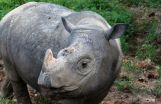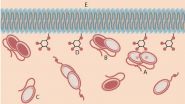(Press-News.org) Leading scientists and experts in the field of rhino conservation state in a new paper that it is safe to consider the Sumatran rhinoceros extinct in the wild in Malaysia. The survival of the Sumatran rhino now depends on the 100 or fewer remaining individuals in the wild in Indonesia and the nine rhinos in captivity.
Despite intensive survey efforts, there have been no signs of the wild Sumatran rhinoceros (Dicerorhinus sumatrensis) in Malaysia since 2007, apart from two females that were captured for breeding purposes in 2011 and 2014. Scientists now consider the species extinct in the wild in Malaysia. The experts urge conservation efforts in Indonesia to pick up the pace.
The conclusions are published online in Oryx, the International Journal of Conservation, led by the Center for Macroecology, Evolution and Climate at the University of Copenhagen. Partners include WWF, the International Rhino Foundation and IUCN, the International Union for Conservation of Nature, which is in charge of the global Red List of Threatened Species.
Surviving rhinos are too far apart
"It is vital for the survival of the species that all remaining Sumatran rhinos are viewed as a metapopulation, meaning that all are managed in a single program across national and international borders in order to maximize overall birth rate. This includes the individuals currently held in captivity", says lead author and PhD student Rasmus Gren Havmøller from the Center for Macroecology, Evolution and Climate.
The experts point to the creation of intensive management zones as a solution; areas with increased protection against poaching, where individual rhinos can be relocated to, in order to increase the number of potential and suitable mating partners.
Historically ranging across most of South-east Asia, the Sumatran rhino is now only found in the wild in Indonesia. Here, less than 100 individuals in total are estimated to live in three separate populations, one of which has seen a critical decline in distribution range of 70 % over the last decade. This trend echoes how the Sumatran rhino population dropped from around 500 to extinction between 1980 and 2005 in Sumatra's largest protected area, the enormous 1,379,100 hectare Kerinci Sebelat National Park.
Apart from the wild populations, nine Sumatran rhinos are in captivity, with one in Cincinnati Zoo in U.S.A (soon to be moved to Indonesia), three held at facilities in Sabah, Malaysia for attempts to produce embryos by in vitro fertilization, and five in the Sumatran Rhino Sanctuary in Sumatra, Indonesia.
Two year old conservation strategy awaits political will
The intensive management zones as well as the single population strategy are two of four key actions identified back in April 2013 at the Sumatran Rhino Crisis Summit in Singapore and agreed upon that same year by the Indonesian government in the Bandar Lampung Declaration.
"The tiger in India was saved from extinction due to the direct intervention of Mrs. Gandhi, the then prime minister, who set up Project Tiger. A similar high level intervention by President Joko Widodo of Indonesia could help pull the Sumatran rhinos back from the brink" says Christy Williams, co-author and coordinator of the WWF Asian and Rhino and Elephant Action Strategy.
Widodo Ramono, co-author and Director of the Rhino Foundation of Indonesia (YABI) elaborates:
"Serious effort by the government of Indonesia should be put to strengthen rhino protection by creating Intensive Protection Zone (IPZ), intensive survey of the current known habitats, habitat management, captive breeding, and mobilizing national resources and support from related local governments and other stakeholders".
The global conservation strategy also included the continued development of Rhino Protection Units at sites with remaining breeding populations. While this has been achieved, the authors highlight a need for strengthening the units against poaching efforts, especially in northern Sumatra. With a high demand for rhinoceros horns in black markets in Asia, poaching continues to be a significant threat to the species.
Finally, captive breeding was included in 2013 as one of the key conservation actions, but the necessary reproductive technology may still take years to develop, during which time we may lose the Sumatran rhino in the wild, says the authors.
INFORMATION:
Reference
Havmøller, R.G. et al., 2015. Will current conservation responses save the Critically Endangered Sumatran rhinoceros Dicerorhinus sumatrensis?. Oryx 2015: (5 pp.) - doi:10.1017/S0030605315000472
An international team of scientists headed by biologists at UC San Diego has discovered that an important class of stem cells known as human "induced pluripotent stem cells," or iPSCs, which are derived from an individual's own cells, can be differentiated into various types of functional cells with different fates of immune rejection.
The scientists also found that these cells may not be rejected by the immune system if iPSCs are turned into retinal pigment epithelium cells destined for the eye.
Their discovery provides hope for the development of human stem cell therapies ...
A team of Swiss geneticists from the University of Geneva (UNIGE), the École Polytechnique Fédérale de Lausanne (EPFL), and the University of Lausanne (UNIL) discovered that genetic variation has the potential to affect the state of the genome at many, seemingly separated, positions and thus modulate gene activity, much like a conductor directing the performers of a musical ensemble to play in harmony. These unexpected results, published in Cell, reveal the versatility of genome regulation and offer insights into the way it is orchestrated.
Chromatin, a ...
An international group of researchers led by Carnegie Mellon University physicists Mathias Lösche and Frank Heinrich have established the structure of an important tumor suppressing protein, PTEN. Their findings provide new insights into how the protein regulates cell growth and how mutations in the gene that encodes the protein can lead to cancer. The study is published online in Structure, and will appear in the Oct. 6 issue.
Phosphatase and tensin homolog (PTEN) is a known tumor suppressing protein that is encoded by the PTEN gene. When expressed normally, the ...
The hippocampus in the brain's temporal lobe is responsible for more than just long-term memory. Researchers have for the first time demonstrated that it is also involved in quick and successful conflict resolution. The team headed by Prof Dr Nikolai Axmacher from the Ruhr-Universität Bochum (RUB), together with colleagues from the University Hospital of Bonn as well as in Aachen and Birmingham, reported in the journal "Current Biology".
Decision conflicts occur often in everyday life
In their everyday life, people are constantly confronted with decision conflicts, ...
Researchers estimate the 20-year breast cancer-specific death rate for women diagnosed with ductal carcinoma in situ to be 3.3 percent, although the death rate is higher for women diagnosed before age 35 and for black women, according to an article published online by JAMA Oncology.
Ductal carcinoma in situ breast (DCIS) cancer, which is also referred to as stage 0 breast cancer, accounts for about 20 percent of the breast cancers detected through mammography. Some women with DCIS experience a second breast cancer (DCIS or invasive) and a small proportion of patients ...
People with psychopathic characteristics are less likely to be affected by "contagious yawning" than those who are empathetic, according to a Baylor University psychology study.
Yawning after spotting someone else yawn is associated with empathy and bonding, and "catching" yawns happens with many social mammals, among them humans, chimpanzees and dogs, researchers say.
The study -- "Contagious yawning and psychopathy" -- involved 135 college student respondents and was published online in the journal Personality and Individual Differences.
"You may yawn, even if you ...
NEW YORK (August 20, 2015) - No single genetic strain of the widespread Clostridium difficile (C. difficile) bacteria appears to be any more harmful than other strains, according to new research published online today in Infection Control & Hospital Epidemiology, the journal of the Society for Healthcare Epidemiology of America.
The findings contradict previous research suggesting that the emergence of the most severe C. difficile infections (CDI) could be linked with a particular strain known as Ribotype 027 (R027). C. difficile is a highly infectious diarrhea that ...
Bethesda, MD (Aug. 19, 2015) -- Frustrated by a maintenance of certification process that doesn't improve patient care, the American Gastroenterological Association (AGA) this week released a proposed alternate pathway to recertification that is based on established learning theory. 1,3 It eliminates the high-stakes examination and replaces it with active, adaptive, self-directed learning modules that allow for continuous feedback.
AGA shared the proposed pathway with the American Board of Internal Medicine (ABIM), which runs the current maintenance of certification ...
Working parents often worry about sending their toddlers to daycare. But the results of a new study that tracked almost 1,000 Norwegian children enrolled in daycare indicate that working parents can breathe a sigh of relief: The amount of time children spent in daycare had little impact on aggressive behavior.
The study is published in Psychological Science, a journal of the Association for Psychological Science.
"From a public perspective, our findings are important because they should help ease parents' fears about the potential harms of early non-parental child care," ...
Tropical Storm Danny became the fourth named storm of the season on August 18 when it formed in the central Atlantic about 1,660 miles east of the Windward Islands. The Global Precipitation Measurement (GPM) mission core satellite passed over Danny the next day and analyzed the structure of its rainfall.
Danny originated from an African easterly wave that moved off of the coast of Africa 4 days earlier on the 14th of August. Storms that form in this region are known as Cape Verde storms and typically form towards the height of hurricane season.
In a typical season, ...


